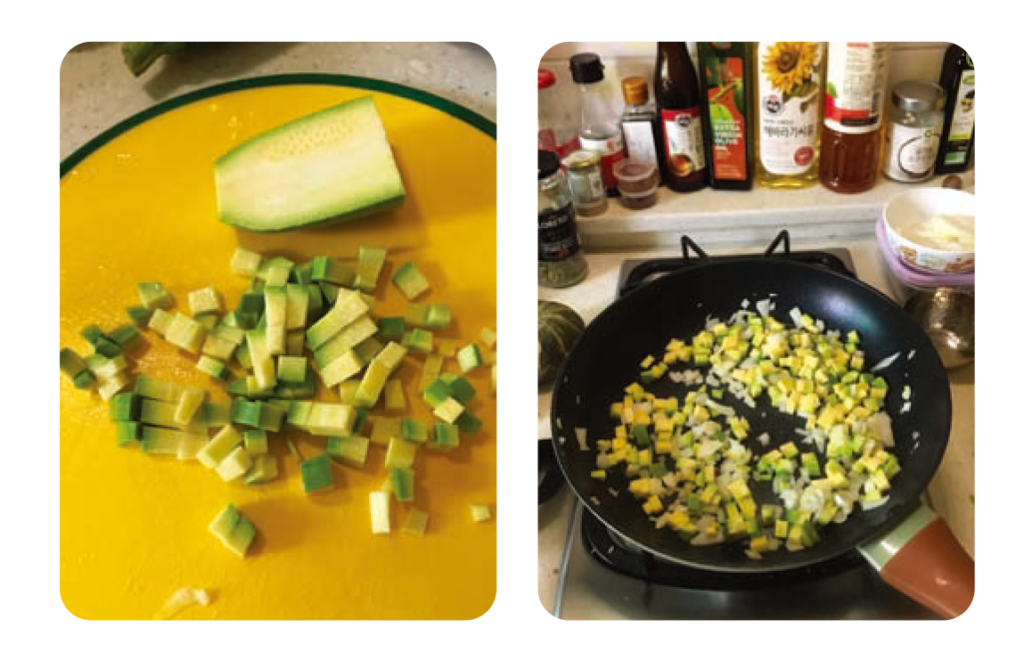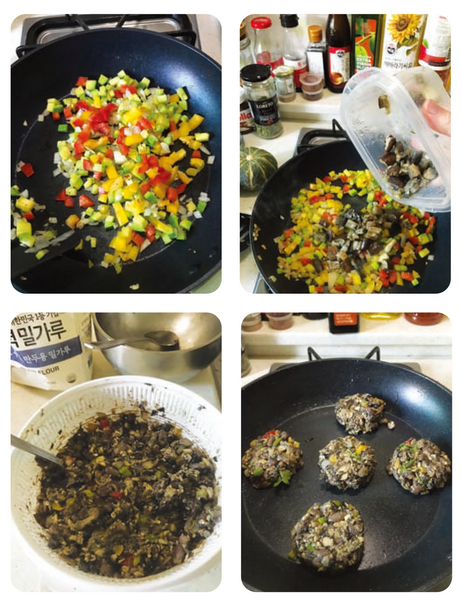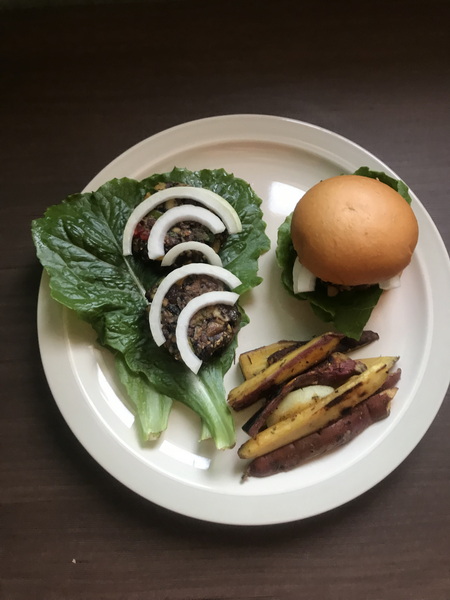Eating Plant-Based: Adaptable Bean Burger Recipe
By Becca Buse
After graduating from college in 2019, I moved to rural Bolivia to work as a volunteer for a non-profit organization, Etta Projects. It was in this community that I learned to cook delicious plant-based meals. I learned many other lifelong skills, such as organic gardening of vegetables, coffee beans, and even medicinal plants. The environment made the transition from eating meat to being plant-based comfortable. I found it quite easy to become a vegetarian when there were no temptations around. I could not even bring meat or fish to the kitchen.
However, Gwangju is a very different environment, where my apartment is surrounded by Korean BBQ and other meat restaurants. I have heard people tell me I am brave to be a vegetarian in Korea since so much of the food culture surrounds meat. Yet, I decided to stay vegetarian since I had already been vegetarian for nearly two years by the time I moved to Korea in February 2021. But it has been challenging. Many Koreans have asked me why I do not eat chicken or pork. They tell me, “It’s so delicious,” or even, “Don’t you miss eating meat?” To all of those comments, I stay confident in my choice to be vegetarian. After all, since I have become vegetarian, I feel healthier and happier. I also am a vegetarian to care for the planet and produce less waste. In fact, by not eating meat, I can reduce my carbon footprint on the Earth. You too can eat less meat (especially red meats like steak and pork) to reduce carbon waste.
As I reflect on being vegetarian, I always go back to my days living in Bolivia. Every lunch, the volunteers rotated cooking. For a year, I cooked one or two meals a week for a dozen people. I learned to try new flavors in beans, use rice, quinoa, and potatoes creatively, and I even started making breads like sourdough and pizzas! The easiest recipe I learned was from watching another volunteer from the Czech Republic. He was really creative with using leftover food from lunch. Once a week, he would take all the leftover beans and vegetables, and combine them with a little flour to make bean burgers. This recipe is what I will be sharing with you all here. It is an adaptable recipe, which means you can use any vegetables you already have or buy your favorites. You also can use your favorite beans, or protein, and your choice of flour, potato, or quinoa!
The Recipe
Serves 4–6 people
Prep time: 10 minutes
Cooking time: 30 minutes

Ingredients
2–3 cups of cooked beans: kidney beans, black beans, lentils
1 cup of cooked vegetables: zucchini, pepper, carrot, eggplant, etc.
1 small onion
3 cloves of garlic (with the oil for sautéing)
Seasoning of your choice: pepper, salt, cumin, chipotle, sesame seeds
1 cup of grains: 3 tbsp flour, 3 tbsp oatmeal, 2 tbsp flaxseed powder or quinoa
Serve on lettuce as an open sandwich, or on bread of your choice. It also goes well with avocado and cilantro with chipotle mayo (vegan options available at E-Mart).
Preparation
- To begin this recipe, check your fridge for any cooked beans, vegetables, or ingredients you may already have. This recipe works best if you use what you already have, instead of buying ingredients solely for this recipe. Be creative and trust your instinct! I checked my fridge beforehand and found two bell peppers, onion, garlic, and cooked eggplant. Then, I went to the store to buy zucchini and lettuce. Next, I checked what to use to bind the ingredients together, I found flour, oatmeal, and flaxseed powder. If you only have one of these ingredients that is great! You can also use quinoa or potatoes.
- Next, if you have cooked beans and vegetables, skip ahead to Step 3. If you need to cook your beans and vegetables, let us get started! Cook your beans as directed. While they are cooking, mince 3 cloves of garlic and a small onion. Sauté the garlic in an oil of your choice, then add the onion. While the garlic and onion are cooking, dice your vegetables into small cubes (remember, this will be a burger, so think small, bite-sized pieces). I like to cook the zucchini and eggplant first, then add the bell pepper at the end so it stays crunchy. Once my vegetables were cooked, I added the eggplant from my fridge and cooked it for a few more minutes. I love seeing the beautiful colors of all the vegetables! Once everything has been cooked to your liking, set the vegetables aside to cool.
- Once your beans and vegetables are cooked and cool, combine them in a bowl. If the beans or vegetables are too hot, Step 4 will not work as well. Mix and add any seasonings you would like: salt, pepper, cumin, chipotle, sesame seeds, etc. Taste and see how it is before going to the next step. Mash the beans and vegetables together so it becomes half smooth and half chunky. This will help the burger form in the next steps.
- Now you will add the binding agents to keep the burger from crumbling apart. Depending on how soft your beans and vegetables are, you may need to adapt the recipe for the correct consistency. Add around 3 tablespoons of flour, 2 tablespoons of flaxseed powder, and 3 tablespoons of oatmeal. This should be around one cup in total. Slowly add each ingredient, mixing and checking the consistency. When it feels thick enough to form into balls, try one and see if it sticks together. You do not want to add too much, then it would dry out and lose the flavor of the beans and vegetables.
- Finally, heat a non-stick pan on medium-low heat. Then, form your bean burgers, rounding the edges and patting them together. (I prefer smaller sizes, which cook faster). Place 4–5 burgers in the pan at once. Cook on each side for 3 minutes.
- The last step is to assemble the burger. You can serve things on a bed of lettuce or as a traditional burger on bread. Either tastes delicious. I enjoy mine both ways. On bread, I toast the buns, then place mustard on the bottom bun, then lettuce, the bean burger, and onion with ketchup on top. On lettuce, I enjoy it with mustard, ketchup, and onion as well. Another good combination is avocado, cilantro, and chipotle mayo (if you can find these ingredients). I have also made simple wedge potatoes while my beans and vegetables were cooling – it made the meal complete for me. If you are eating alone, keep the remains in your fridge for 2–3 days, or put them in your freezer to enjoy later.


Note: this recipe makes around 15 small burgers and can serve around 4–6 people if each person is eating 2–3 burgers. If you are serving many people, double the recipe, or add more side dishes.
ADDITIONAL WEBSITES FOR INSPIRATION
The Korean Vegan: Enjoy delicious recipes from this website of a Korean-American vegan. https://thekoreanvegan.com/blog/
Cookie and Kate: Check out another veggie burger recipe and other plant-based recipes. https://cookieandkate.com/best-veggie-burger-recipe/
Vegan Space: A website you can order vegan ingredients from. https://veganspace.co.kr/
Etta Projects: http://www.ettaprojects.org/
Photographs by Becca Buse.
The Author
Becca Buse has been an ESL teacher in Gwangju since March of 2021. Before moving to Korea, she lived in Bolivia; Minneapolis, Minnesota; and Nottingham, England. She has a degree in international studies and a minor in English writing. As a global thinker, Becca is an advocate for protecting the Earth, caring for communities, and peace-building. In her free time, she enjoys hikes with the Gwangju Hikers Club, cooking, and reading fiction.
Instagram @bkahbuse







